One of the highlights of the fly fishing process is choosing just the right fly. There is a real art to figuring out just what the fish want to eat and having a lure that matches their precise tastes. Trout are simultaneously voracious and picky, a paradox many trout anglers have noted over the years, and so when you’re out on the water, it helps to have a variety of flies to choose from.
Fly fishing flies can be divided into two types: dry flies, which sit on top of the water, and wet flies, which sink into the water column. Today, we’re going to be discussing wet flies and which ones you should always keep in your fly box.
You should bring several of your favorite patterns. Fly loss is a common occurrence, especially when nymphing or otherwise fishing wet flies. Underwater hazards like logs and other debris can steal your fly, or you may lose a fly to an unraveled knot or a snarled line you have to cut. So make sure to bring a couple of copies of any of the patterns in this article on your next fishing expedition!
Choosing The Best Wet Flies for Trout
There are several types of wet flies you can use. The first type we will discuss is emergers, a fly that mimics an emergent insect (a pupated insect that is swimming upwards towards the water’s surface) or sometimes a drowned nymph or adult rising to the surface.
Nymphs are another type of wet fly that many anglers swear by. Nymphs are tied on very small hooks and are often fished with two nymphs on the line under a dry fly or other indicator. When choosing flies for trout, you need to know about local entomology and try to match the hatch. Specifically, you need to think about what types of insects are hatching and are in their aquatic states. You aren’t trying to match adult insects in many cases here; instead, you’re mimicking the larval insects. If you’ve ever wondered why it’s called nymphing, this is why– the larval state of an aquatic insect is often called a nymph.
Streamers are another great option for wet flies. Streamers mimic the action of an animal swimming in the water. This could be annelids like worms and leeches, crayfish, insects that have been swept in off of the bank, or baitfish.
Now that you have a general idea of what the different types of flies can do, let’s look at the must-haves for your fly box.
Best Emerger Flies for Trout Fishing
These flies should be fished above the bottom, since they mimic insects that rise in the water column. If you’re fishing a two-fly setup, an emerger makes a great second fly behind a nymph pattern lead fly.
Barr Emerger
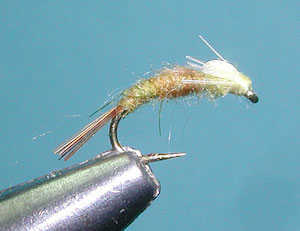 Developed in 1975, this emerger pattern came about after PMD (pale morning dun mayflies) patterns failed to attract trout. John Barr set up this pattern to mimic the emergent stage of that mayfly, although many mayflies look similar at this stage.
Developed in 1975, this emerger pattern came about after PMD (pale morning dun mayflies) patterns failed to attract trout. John Barr set up this pattern to mimic the emergent stage of that mayfly, although many mayflies look similar at this stage.
- Imitates: Mayfly emergers
- Typical Size: 16-22
- Variations: Color variations to match local mayflies, including the popular blue-winged olive
Hare’s Ear Emerger/Soft Hackle Hare’s Ear
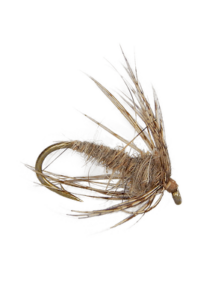 This classic 1920s fly pattern is a variation on the hare’s ear theme popular with fly anglers worldwide. The soft hackle mimics wings emerging out of a pupa.
This classic 1920s fly pattern is a variation on the hare’s ear theme popular with fly anglers worldwide. The soft hackle mimics wings emerging out of a pupa.
- Imitates: Damselfly or callibaetis mayfly
- Typical Size: 10-20 or smaller
- Variations: Several different color options and hackle feather choices
See on Amazon | See on Discount Flies
RS2
 The RS2, is a must-have for every angler’s fly box. It can be effectively employed at any location in the water column throughout the year and proves its efficiency in virtually all trout-inhabited waters. Notably, it has gained a strong reputation for its effectiveness in tailwater streams.
The RS2, is a must-have for every angler’s fly box. It can be effectively employed at any location in the water column throughout the year and proves its efficiency in virtually all trout-inhabited waters. Notably, it has gained a strong reputation for its effectiveness in tailwater streams.
- Imitates: Midge or mayfly emergers
- Typical Size: 18-28
- Variations: Several color options, including pale yellow, olive, black, and gray
Best Nymphs for Trout Fishing
Ask any fly fisher what the best nymphs for trout fishing are, and you will get a variety of answers. There are lots of great nymphs to choose from.
Hare’s Ear
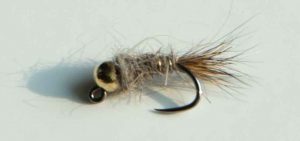
Hare’s Ear Nymph
The Hare’s Ear is one of the most recognizable wet flies. It has a cult following; there are some anglers who refuse to use anything else. Since the colors don’t mimic any specific species of mayfly– just mayfly larvae in general– you can use this fly if any species is present in the water.
- Imitates: Mayfly larvae
- Typical Size: 10-18
- Variations: Gold-ribbed Hare’s Ear
Iron Lotus
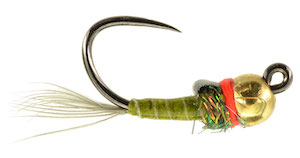 This pattern uses a secret ingredient– nail polish– to create a hard, fast-sinking body
This pattern uses a secret ingredient– nail polish– to create a hard, fast-sinking body
- Imitates: Any dark nymph
- Typical Size: 14-18
- Variations: Gold-ribbed Hare’s Ear
See on Amazon | See on Trident Fly Fishing
Pheasant Tail
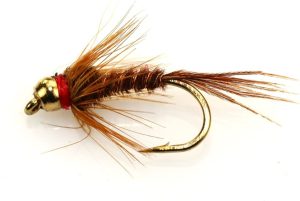 The pheasant tail is something between an attractor and a natural pattern. It has a broad appeal for trout and mimics many different insects.
The pheasant tail is something between an attractor and a natural pattern. It has a broad appeal for trout and mimics many different insects.
- Imitates: Many nymphs
- Typical Size: 12-20
- Variations: Pheasant Tail Flashback, American Pheasant Tail, Mostly Pheasant, Pheasant Tail Peacock Thorax
Prince Nymph
 This nymph is an attractor pattern, meaning that it doesn’t represent any specific nymph. The bead head, lead wire, and other features are appealing to fish, often triggering strikes. It features in many double-fly setups.
This nymph is an attractor pattern, meaning that it doesn’t represent any specific nymph. The bead head, lead wire, and other features are appealing to fish, often triggering strikes. It features in many double-fly setups.
- Imitates: Attractor
- Typical Size: 4-18
- Variations: Many, including Rainey’s Prince, Alison’s Purple Wild Thing, Black Jack, Maldonato’s Casino Royale, and Purple Prince Charming
San Juan Worm
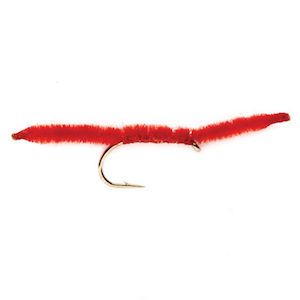 The San Juan Worm is a simple yet highly effective fly pattern resembling a segmented aquatic worm. Typically tied in shades of red or pink, it’s a go-to choice for imitating annelid worms in aquatic environments, making it a reliable option for enticing trout and other freshwater species.
The San Juan Worm is a simple yet highly effective fly pattern resembling a segmented aquatic worm. Typically tied in shades of red or pink, it’s a go-to choice for imitating annelid worms in aquatic environments, making it a reliable option for enticing trout and other freshwater species.
- Imitates: Worms
- Typical Size: 12-16, although some much larger variations tied on 4 and 6 hooks exist
- Variations: Size and color variations
Zebra Midge
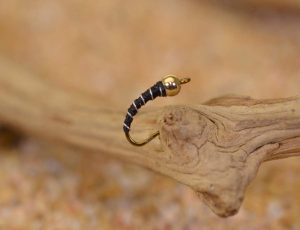 One of the easiest flies to tie, the Zebra Midge is a small but mighty fly that works on all types of fly waters. It mimics juvenile midges, which can be found year-round in most waters where you can find trout. Carry this in several sizes and color variations– it’s a very reliable pattern.
One of the easiest flies to tie, the Zebra Midge is a small but mighty fly that works on all types of fly waters. It mimics juvenile midges, which can be found year-round in most waters where you can find trout. Carry this in several sizes and color variations– it’s a very reliable pattern.
- Imitates: Midges
- Typical Size: 16-28
- Variations: Can be tied in multiple colors, including red and green
The Best Scuds and Sowbugs for Trout Fishing
We’re going to discuss scuds and sowbugs separately from other nymphs because of their year-round utility. Scuds and sowbugs aren’t insects– they’re tiny crustaceans. They live on river bottoms and are a common prey item year-round. Because these prey items are always in the water, you can always use them. Here are a few of the best scud and sowbug patterns for trout.
Bead Body Scud
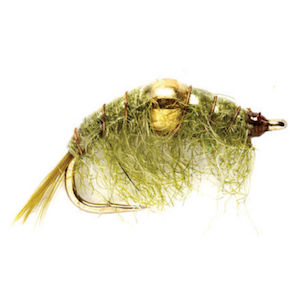 This scud pattern incorporates a mid-body bead to enhance both sink rate and subtle attraction flash, making it an ideal choice for still water applications where you aim to swiftly reach the desired depth in the water column and employ a slow retrieve.\
This scud pattern incorporates a mid-body bead to enhance both sink rate and subtle attraction flash, making it an ideal choice for still water applications where you aim to swiftly reach the desired depth in the water column and employ a slow retrieve.\
- Imitates: Scuds
- Typical Size: 12-14
- Variations: Beaded shrimp, color and size variations
Czech Mate
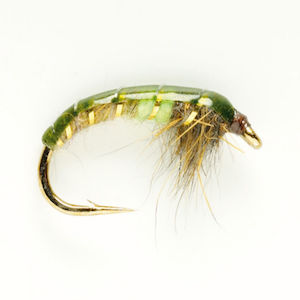 A compact scud pattern that fishes well in fast riffle water. Bright colors can also look like roe, and muted colors also resemble caddis nymphs.
A compact scud pattern that fishes well in fast riffle water. Bright colors can also look like roe, and muted colors also resemble caddis nymphs.
- Imitates: Scuds, fish eggs
- Typical Size: 12-16
- Variations: Can be tied in green, cream, red and other colors
Killer Bug
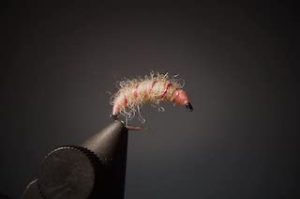 This storied fly was developed by the famed Frank Sawyer to help control grayling numbers on the River Avon. For trout, stick to smaller Killer Bugs– the larger sizes are better for bigger fish like salmon. This is an incredibly easy fly to tie– all you need is wool, thread, and copper wire.
This storied fly was developed by the famed Frank Sawyer to help control grayling numbers on the River Avon. For trout, stick to smaller Killer Bugs– the larger sizes are better for bigger fish like salmon. This is an incredibly easy fly to tie– all you need is wool, thread, and copper wire.
- Imitates: Scuds, fish eggs
- Typical Size: 10-14
- Variations: Utah Killer Bug, Bug and Starling (added soft hackle)
The Best Streamers for Trout Fishing
The largest wet flies are streamer patterns. Streamers can be very appealing to larger trout and can mimic a number of creatures. There are a number of streamers that don’t mimic anything in particular– attractor patterns often work well as flies of this size.
Black-Nosed Dace
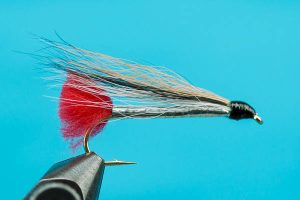 This simple, effective streamer is great because it mimics many small baitfish. It’s a generic minnow or dace pattern, so it never looks out of place in the water.
This simple, effective streamer is great because it mimics many small baitfish. It’s a generic minnow or dace pattern, so it never looks out of place in the water.
- Imitates: Minnows, dace
- Typical Size: 2/0-10
- Variations: Mickey Finn, Little Rainbow Trout
Clouser Deep Minnow
 This is a larger pattern– so much so that “to clouser” your rod means to lose control over the tip because you weren’t expecting such a heavy fly. An unusual, brightly-colored fly, these streamers are best for large trout and behave more like jigs than other types of flies.
This is a larger pattern– so much so that “to clouser” your rod means to lose control over the tip because you weren’t expecting such a heavy fly. An unusual, brightly-colored fly, these streamers are best for large trout and behave more like jigs than other types of flies.
- Imitates: Attractor, nonspecific baitfish.
- Typical Size: 2/0-10
- Variations: Freshwater Clouser
Marabou Leech
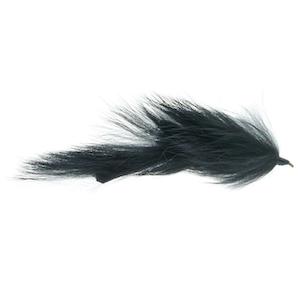 The fluffy feathers of the marabou leech give it great movement underwater, helping it mimic plenty of soft-bodied snacks that trout can’t resist. Smaller sizes are better for trout.
The fluffy feathers of the marabou leech give it great movement underwater, helping it mimic plenty of soft-bodied snacks that trout can’t resist. Smaller sizes are better for trout.
- Imitates: Leeches and annelids
- Typical Size: 10-4
- Variations: Bunny leech; many color variations
See on Amazon | See on Trident Fly Fishing
Muddler Minnow
 Designed originally for brook trout, the Muddler Minnow doesn’t mimic a specific type of baitfish; rather, its mottled appearance and movement mimic a number of terrestrial and aquatic prey items.
Designed originally for brook trout, the Muddler Minnow doesn’t mimic a specific type of baitfish; rather, its mottled appearance and movement mimic a number of terrestrial and aquatic prey items.
- Imitates: Minnows, sculpins, crayfish, large insects
- Typical Size: 2-12, up to 3x-4x long
- Variations: Various colors
Wooly Bugger
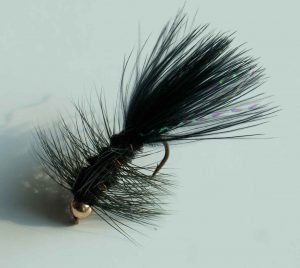
Wooly Bugger
The Wooly Bugger is an absolute staple fly to have in your kit. It doesn’t look like any specific insect or prey item, and its movement in the water replicates almost anything a trout might want to eat.
- Imitates: Big nymphs, baitfish, leeches, drowning terrestrial insects, worms, and small crustaceans
- Typical Size: 2-12
- Variations: Wooly Worm, Palmer Fly; lots of color variations
Choosing Flies For Any Situation
When choosing the best wet flies for trout, it’s never a one-size-fits-all scenario. Flies that perform well during one season might not perform as well in the next. Fish might be biting in one part of the stream and ignoring your flies in another part. You have several things to consider when choosing a fly for the situation.
Depth Matters
Where you put the fly in the water column is important. While dry flies stay on the surface, wet flies can go to the bottom, stay near the top, or hang anywhere in between. In some situations, you may need to get your fly down to where the trout are holding, especially in fast-flowing or deep waters. Other times, you want your fly to stay in the mid-water column or even near the surface. It all depends on where the fish are willing to bite.
Heavy vs. Light Flies
When you need to get deep quickly, using heavy flies is essential. These flies, like bead-head nymphs and streamers, are typically weighted with materials like tungsten beads, and they sink rapidly. Choose heavier flies when fishing in deeper pools or during fast currents. Choose lighter flies when you’re in still waters or want less movement.
Smaller vs. Larger Flies
Smaller wet flies, even if they are lightweight, can still sink relatively quickly due to their streamlined design. These are excellent choices when you need to reach specific depths without the extra weight. They work well for imitating smaller aquatic insects or when trout are feeding near the surface. If the trout are feeding mid-water or towards the bottom, larger flies may be more tempting.
Emergers and Non-Weighted Flies
Emerger patterns or non-weighted flies are designed to mimic insects rising from the depths to the surface. These can be fished in the mid-water column effectively. They provide a more natural presentation for trout suspended in the water column or actively feeding near the surface. Use these flies when you don’t want to get all the way down to the bottom, or as a tailing fly behind a fly that is sitting on the bottom.
Size Selection
Matching the hatch isn’t just about what species of insects are present; you also must pay attention to the size of the insects being eaten. When trout are feeding on smaller insects like midges or mayflies, opt for smaller wet flies. Conversely, when larger insects or baitfish are prevalent, go for larger patterns.
It’s also a good idea to carry a variety of sizes in your fly box. This allows you to adapt to changing conditions and insect activity throughout the day. Sometimes, trout may switch their preference from small to large insects, or vice versa, as the day progresses.
Color Selection
Choosing the right color for your wet fly can make a significant difference. Natural colors like olive, brown, and black often imitate real insects and can be effective in most situations. However, in some cases, using more attractive, flashy colors like chartreuse or orange can trigger aggressive strikes, especially in murky water or low light conditions.
Don’t be afraid to experiment with different colors to see what the trout are responding to on a given day. Observing the behavior of the fish and the prevalent forage can help you determine the most suitable color patterns.
Selecting the best wet fly for trout involves a combination of factors such as depth, size, what’s hatching, and color. Being able to adapt to changing conditions and reading the water and trout behavior will ultimately lead to more success on the river. Remember that while these principles provide a solid foundation, local knowledge and experience can often be the best guide for fly selection in specific fishing locations. Ask around at local fly shops to see what the fish are hitting and what the hatch is like.
Max DesMarais is the founder of hikingandfishing.com. He has a passion for the outdoors and making outdoor education and adventure more accessible. Max is a published author for various outdoor adventure, travel, and marketing websites. He is an experienced hiker, backpacker, fly fisherman, backcountry skier, trail runner, and spends his free time in the outdoors. These adventures allow him to test gear, learn new skills, and experience new places so that he can educate others. Max grew up hiking all around New Hampshire and New England. He became obsessed with the New Hampshire mountains, and the NH 48, where he guided hikes and trail runs in the White Mountains. Since moving out west, Max has continued climbed all of the Colorado 14ers, is always testing gear, learning skills, gaining experience, and building his endurance for outdoor sports. You can read more about his experience here: hikingandfishing/about
